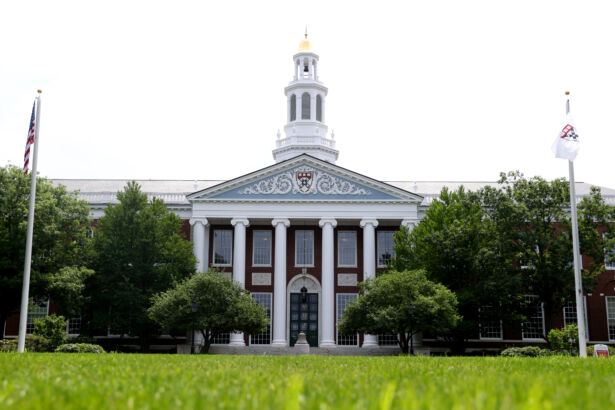News Analysis
As Harvard and the University of North Carolina (UNC) await a landmark Supreme Court decision, expected this week, on their racial admissions policies, companies are also watching nervously, fearing that the decision could expose their race-based hiring and training programs to civil rights lawsuits.
According to a Harvard Business Review 2022 survey, more than 60 percent of U.S. companies had a diversity, equity, and inclusion (DEI) program, which categorizes employees according to race and gender. In addition, following the 2020 police murder of George Floyd, a black man, numerous companies including Wells Fargo, United Airlines, JPMorgan Chase, Delta Airlines, Ralph Lauren, Estee Lauder, and Google parent company Alphabet Inc. announced race-based hiring and promotion policies.
In addition to race considerations, Salesforce, a technology company, said it plans to have 40 percent of its employees be people who identify as women or nonbinary by the end of 2026. The problem for these corporations, experts say, is that these policies, while trendy, are likely illegal under U.S. laws, which explicitly prohibit discrimination by race and gender.
“It’s become very popular, especially in the last three or four years, to have these race-based initiatives, and they are only beginning to be tested against the Civil Rights Act or against the Constitution,” Erin Wilcox, an attorney at the Pacific Legal Foundation, told The Epoch Times. Wilcox is representing students who claim that admissions policies at Thomas Jefferson High School in Virginia are discriminatory, in a case being appealed to the Supreme Court.
“I think it was really caused by a certain boldness on the part of our public officials and corporate America in believing that these rules didn’t apply to them, or that what they were doing is more important,” she said. “I think we’re seeing a proliferation that’s going to be reined in, starting probably with the Harvard and UNC cases, and I think certainly others down the pike.”

Execs, Lawyers Meet to Plan Next Steps
A June 21 Wall Street Journal report surveyed several corporate executives and human resources directors, who said that they are having internal meetings with their legal teams to discuss how to move forward with diversity programs if the Supreme Court decides against Harvard and UNC. Some companies are considering removing “diversity” from job titles, perhaps replacing them with titles like “chief transformation officer.” Others plan to keep their policies just as they are.
A January joint report on DEI by McKinsey, a consultancy, and the World Economic Forum, stated that in 2020, “companies worldwide spent $7.5 billion on DEI-related efforts, a figure that is projected to more than double to $15.4 billion by 2026 …Yet at the current rate it will take another 151 years to close the global economic gender gap at all levels.” The report details case studies and “success factors” to help executives advance a DEI agenda.
But some legal experts say that race-based agendas, however they may be called, are likely violating not only federal laws but state laws as well.
“There are laws against discrimination in New Jersey, and the Human Rights Act in New York; there are parallel statutes in California,” Dan Morenoff, executive director of the American Civil Rights Project, told The Epoch Times.
“Most of these statutes have provisions for uncapped punitive damages,” he said. “When you’re talking about uncapped punitive damages and entities that are among the largest in the world, it’s difficult to even put into words the scale of that Pandora’s box of liability that corporate directors have chosen to open.”

Multi-million-dollar Awards for Civil Rights Violations
Two weeks ago, a New Jersey jury awarded a Starbucks employee, who is white, $600,000 in compensatory damages and $20 million in punitive damages, agreeing with her claim that the company fired her because of her skin color over a situation in which two black men were arrested in a coffee shop in her district. The manager of that Starbucks shop, who was black, was not fired.
“That was just for one person,” Morenoff said. “As the plaintiffs’ bar sees that these are real sources of recovery, I would be surprised if you didn’t see a lot more of these cases being brought.”
Morenoff’s organization has been representing shareholders in legal actions to compel companies like Starbucks to remove racially discriminatory policies to protect company owners from costly employee lawsuits. But many executives seem intent on pursuing racial equity despite the risks to shareholders.
If the Supreme Court rules against the universities, Wilcox said, “what schools are going to do next, and I think what a lot of companies are going to do … is to use proxies to get the racial balance they want.”
For schools, racial proxies included practices like limiting the number of admissions from certain schools that were known to have a high percentage of Asian students, or giving preference to applicants from certain zip codes known to contain predominantly minority neighborhoods.
“On the face of it, you’re not using racial classification,” Wilcox said. “But you’re still getting the same thing you want and discriminating against people based on their race. So that’s going to be a question for the Supreme Court to decide next; is that also a violation of the equal protection clause?”
The Roots of Affirmative Action
The legal justification for enacting race-based policies despite explicit civil rights laws to the contrary stems from two sources. First, a 1965 executive order issued by President Lyndon Johnson that required all government contractors to take “affirmative action” to increase job opportunities for minorities. And second, Supreme Court cases like the 2003 decision in Grutter v. Bollinger, which ruled that “the use of an applicant’s race as one factor in an admissions policy of a public educational institution does not violate the Equal Protection Clause of the Fourteenth Amendment if the policy is narrowly tailored to the compelling interest of promoting a diverse student body.”
In an amicus brief regarding the Harvard and UNC case, the Hamilton Lincoln Law Institute and attorney Ilya Shapiro argued that “what this Court authorized in Grutter as a temporary, grudging exception to America’s ideals and generally applicable law of Equal Protection … has metastasized into a threat blooming across the legal landscape, the economy, and society as a whole.”
The exceptions granted by the Grutter case were narrowly tailored to government-funded universities’ admissions policies, and were intended to be a temporary remedy that would include “sunset” provisions. But corporations have applied them as a precedent to race-based policies on staffing and training, and expanded them to include new racial goals.
“To the extent that corporate America has thought that Grutter provided some kind of fig leaf to the illegal discrimination they’ve been engaging in for the last two decades, this would be a really good time for them to rethink that,” Morenoff said. “It never made sense for corporate America to argue that there was a diversity rationale exception to our civil rights laws,” he said.
However, if the Supreme Court decision reverses Grutter or the Johnson executive order, even that questionable pretense would be gone. Rather than standing on thin ice, Morenoff said, “they’re standing on no ice at all.”
“Remedying past racial discrimination is actually a compelling state purpose; it has been held to be one of the proper remedies for violations of civil rights laws,” he said. “If there actually is a recent past discriminatory action, which a corporation or anyone else is correcting, that’s legal. But the truth is that almost all the programs we’re talking about are not remedial.
“They’re pitched under the business case for diversity, and their argument is that discrimination is popular, discrimination will earn us points with our customers, and discrimination is going to be generating a broader diversity of opinions that will allow us to make better decisions,” Morenoff said. “None of that has anything to do with remediating past harm; it is all hypothetically profit-seeking.”
“In the past, these affirmative action programs in the business world had existed to remedy specific discrimination that a company had done previously,” Wilcox said. “The DEI policies are a new breed. They’re just seeking diversity for diversity’s sake, and we really have not had a high court ruling on whether that is acceptable under federal law.”
From The Epoch Times
